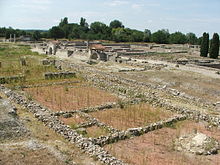Jenő Fitz
Jenő Fitz (born February 5, 1921 in Budapest ; † November 9, 2011 there ) was a Hungarian provincial Roman archaeologist and numismatist who also dealt with epigraphy and prosopography . He became known in the international professional world, in particular through some important writings on the Roman history of his home country. Fitz was one of the most important archaeologists in Hungary. His archaeological life's work is the excavations in the Roman city of Gorsium , which he directed from the beginning.
Life
Fitz was born in Budapest as the son of József Fitz and Margit Rónay. From 1931 to 1933 he attended the Lajos-Nagy-Realgymnasium in Pécs and from 1934 to 1939 the Szent-Benedek-Realgymnasium in his hometown. He then studied from 1939 to 1943 at the Budapest Royal Péter Pázmány University and worked at its Institute for Classical Archeology from 1946 to 1949, initially as an intern and later as an assistant professor. From 1946 to 1969 he was also a lecturer there . During this time, in 1947, he received his doctorate on memories of Hercules in Pannonia . The following year he married Éva Petres. This marriage resulted in two children, including the art historian Péter Fitz, who was born in Budapest on April 28, 1950 .
In 1949 Jenő Fitz took over the position of director at the St. Stephen's Museum in Székesfehérvár and stayed there until 1985. From 1958 he directed the excavations in Gorsium, north of Lake Balaton , and from 1960 he became the editor of the specialist journal Alba Regia . In 1962 he also took the position of director of the museum service in Fejér county and received his doctorate in 1985 as an ancient historian with a thesis on the administration of the Pannonian provinces in the late period of the Roman Empire .
Fitz was a member of the Hungarian Society of Archeology and Art History ( Magyar Régészeti és Művészettörténeti Társulat ), the Hungarian Numismatic Society ( Magyar Numizmatikai Társulat ), the international Greco-Latin epigraphic Company ( A Nemzetközi Görög-Latin Epigráfiai Társaság ) and was a regular member of the German Archaeological Institute and the Austrian Archaeological Institute .
Honors and prizes
He has received numerous awards, such as the Széchenyi Prize (1997), the Károly Maróth Prize (1995), the Ferenc Móra Medal (1995), the Dénes Deák Medal (1990), the László Réthy Medal (1985), the Flóris-Rómer Medal (1982), the Jenő-Ábel Medal (1978) and the Bálint-Kuzsinszky Medal (1960).
Fonts (selection)
Books
- Székesfehérvár and surroundings - Lake Velence - Gorsium. Ma Kiadó, Székesfehérvár 1998.
- The administration of Pannonia in Roman times. Four volumes. Encyclopedia, Budapest 1993-1995.
- A walk through the old Székesfehérvár (Chair White Castle). István Király Múzeum, Székesfehérvár 1992, ISBN 963-7131-69-8 .
- The Pannonian Century (193–284). Corvina Kiadó, Budapest 1982, ISBN 963-13-1259-3 .
- The circulation of money in the Roman provinces in the Danube region in the middle of the 3rd century. Akadémiai Kiadó, Budapest 1978, ISBN 963-05-0858-3 .
- Gorsium - Herculia. István Király Múzeum, Székesfehérvár 1970.
- Gorsium. Researches. Fejér Megyei Múzeumok Igazgatósága, 1974.
- Gorsium - Herculia - Tác. Corvina Kiadó / Pannonia, Budapest 1973.
- The career of the governors in the Roman province of Moesia inferior . Böhlau, 1966.
- Gorsium. Fejér Megyei Tanács Idegenforgalmi Hivatala, Székesfehérvár 1960.
- István Király Múzeum Közleményei. The statue of Hercules v. Baracska. A baracskai Hercules szobor. Volume 19. István Király Múzeum, Székesfehérvár 1965.
- A Fejer megyebe hurcolt római kövec kérdéséhez. On the question of stone monuments from Roman times that were dragged to Fejér County. István Király Muzeum, Székesfehérvár 1958.
Editing
- The Roman Limes in Hungary. Fejér Megyei Múzeumok Igazgatósága, 1976.
- with Sándor Soproni and András Mócsy: The territory of Aquincum, the Civitas Eraviscorum and the Limes stretch of Matrica-Annamatia and the territory of Gorsium. In: the series: The Roman Inscriptions of Hungary (RIU). 6. Delivery. Enciklopédia Kiadó, Budapest and Rudolf Habelt Verlag, Bonn 2001, ISBN 3-7749-3054-6 .
- Intercisa. In: the series: The Roman Inscriptions of Hungary (RIU). 5. Delivery. Budapest and Rudolf Habelt Verlag, Bonn 1991, ISBN 3-7749-2436-8 .
- The coins found in the Roman period in Hungary, volume 1. Fejér county. Rudolf Habelt Verlag, Bonn 1990, ISBN 3-7749-2407-4 .
Articles (selection)
- Gorsium - Herculia. Part I: Research 2. In: Alba Regia. Vol. 34. Stuhlweissenburg 2005. pp. 45-80.
- The holy district of the imperial cult in Lower Pannonia. In: Alba Regia. Vol. 32. Stuhlweissenburg 2003. pp. 7-40.
- The cities of Pannonia. In: Situla. Razprave narodnega Muzeja v Ljubljani. Vol. 41. Laibach 2003. pp. 47-52.
- Problems of the division of the Illyricum into two parts. In: Alba Regia. Vol. 29. Stuhlweissenburg 2000. pp. 65-73.
- Pannonian knights. In: Alba Regia. Vol. 29. Stuhlweissenburg 2000. pp. 115-136.
- The visit of Septimius Severus in Pannonia in the year 202. In: Acta Archaeologica Academiae Scientiarum Hungaricae. 11, 1959. pp. 237-263.
literature
- Péter Hermann, Antal Pásztor: Magyar és nemzetközi ki kicsoda. (The Hungarian and international Who's Who) Biográf, 1994, ISBN 963-7943-27-7 , p. 295.
- Festschrift for Jeno Fitz = Jeno Fitz Septuagenario, Székesfehérvár 1996 (with complete list of publications).
Web links
- Literature by and about Jenő Fitz in the catalog of the German National Library
Remarks
- ↑ Kilencven éves korában elhunyt Dr. Fitz Jenő ( Memento of the original from June 8, 2016 in the Internet Archive ) Info: The archive link was inserted automatically and has not yet been checked. Please check the original and archive link according to the instructions and then remove this notice. . szekesfehervar.hu . Retrieved November 14, 2011. (Hungarian)
| personal data | |
|---|---|
| SURNAME | Fitz, Jenő |
| BRIEF DESCRIPTION | Hungarian provincial Roman archaeologist, historian and numismatist |
| DATE OF BIRTH | February 5, 1921 |
| PLACE OF BIRTH | Budapest |
| DATE OF DEATH | November 9, 2011 |
| Place of death | Budapest |
